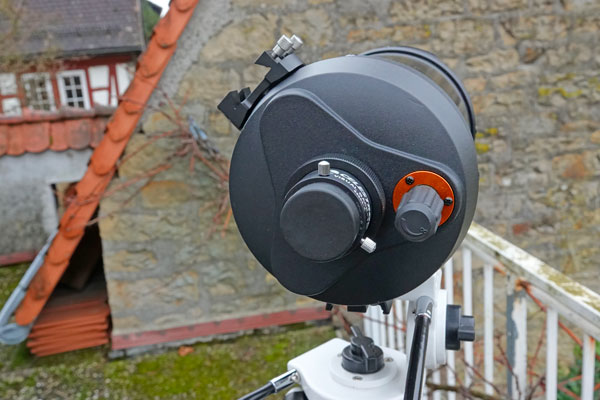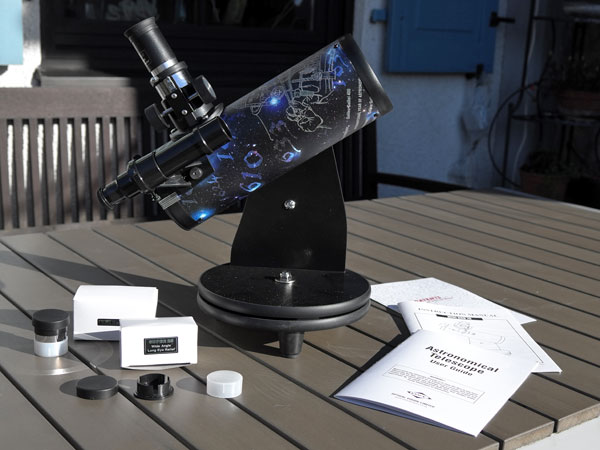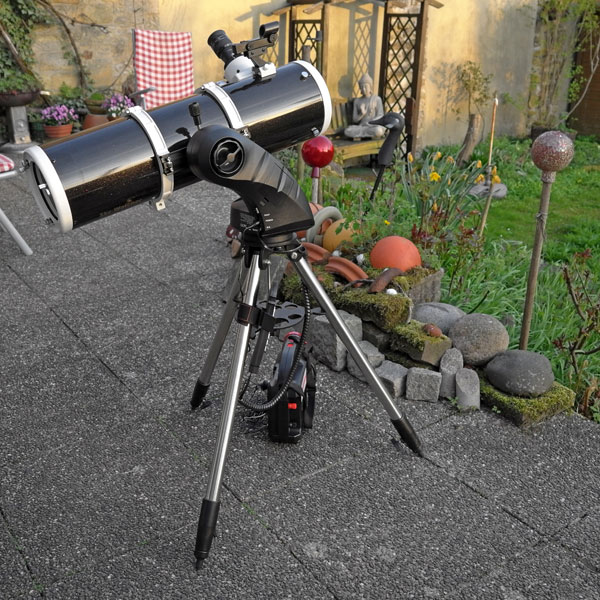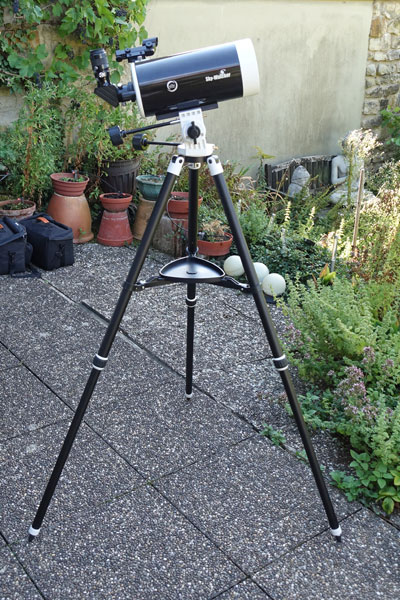Overview of All My Telescopes
Bresser Venus 76/700 AZ | Meade ETX-90EC | Meade 10" Dobson Lightbridge | Sky-Watcher Heritage 76 | Sky-Watcher Heritage 100P | Sky-Watcher Heritage P130 | GSO 8" Dobson GSD 680 | Sky-Watcher Heritage 114P Virtuoso | Sky-Watcher Skymax-102 OTA | Sky-Watcher Explorer 150PDS | Sky-Watcher Skymax-127 OTA | Omegon Photography Scope 72/432 OTA | Celestron C8 OTA | Unistellar eVscope | TS-Optics Photoline 102/714 | Celestron C5 OTA | Vaonis Vespera | Unistellar eVscope 2 | Vaonis Vespera Pro | TS-Optics Photoline 80/480 | Links
On this page, I present some information about all the telescopes* that I own(ed) - the past ones and the the current ones.
*) I do not present the telescope for children Sky-Watcher/Omegon Infinity 76 here (given away in January 2019)...
Notes
-
See the table of data for all of my telescopes (and a few more...) for a tabular overview of the data for the telescopes.
-
Here is an overview of my current telescopes.
Bresser Venus 76/700 AZ (1998? - 1999)
Views of my Bresser Venus 76/700 AZ Newtonian telescope which I found in my photo collection. It was my very first telescope and I do no longer know when and where (Aldi or Tchibo, I assume...) I purchased it. I sold it in 1999, after I had acquired a Meade ETX-90EC.
For details see page Bresser Venus 76/700 AZ Information. For technical data see here.
Meade ETX-90EC (May 1999 - End of 2009)
Purchased in 1999 at the Pittsburgh airport and used for observing a solar eclipse in the same year. Sold at the end of 2009, because the telescope was not suited to observing deep sky objects (nebulae, galaxies) due to its focal ratio (f/13.8) - it is an ideal telescope for observing the moon, the sun (with a filter), and planets.
For details see pages Meade ETX-90EC Information and Meade ETX-90EC Equipment. For technical data see here.
Meade 10" Dobson Lightbridge (October 2009 - March 2016)
Purchased in October 2009. Sold in March 2016, because the telescope had become too heavy for me (the tubus weight was over 17 kg, the complete weight was about 31 kg). This telescope delivered the best results of all telescopes that I had owned so far. I replaced it with a GSO GSD 680 8" Dobsonian telescope, which is somewhat lighter. Regrettably, I was not able to compare the two "big" telescopes.
For details see page Meade 10"-Dobson Information. For technical data see here.
Sky-Watcher Heritage 76 (January 2014 - March 2016)
Purchased at the end of January 2014 as a travel scope. Given away in March 2016, because I was not satisfied with the image quality of this telescope. The Heritage 100P, which is a little bit larger, is clearly better in this respect. But I liked the small size and the usability of this nice little telescope.
For details see pages Sky-Watcher 3" Dobson Information and Sky-Watcher Dobson Heritage Comparison. For technical data see here.
Sky-Watcher Heritage 100P (July 2015 - March 2019)
I bought this telescope at the beginning of July 2015 as a travel scope, because I was not satisfied with the image quality of the smaller Heritage 76. It was not as easy to transport as the 76, but performs much better (it has a parabolic mirror) as at least my sample of the 76. Apart from its own mount, I also used the tube on the Sky-Watcher Star Discovery AZ GoTo telescope mount and on the Sky-Watcher AZ Pronto mount. Since this telescope was somewhat redundant with my Omegon Photography Scope 72/432, I decided to part with it, although I liked it very much, and gave it away to my brother at the end of March 2019.
For details see pages Sky-Watcher 4" Dobson Information and Sky-Watcher Dobson Heritage Comparison. For technical data see here.
Sky-Watcher Heritage P130 (February 2010 - April 2017)
Purchased in February 2010, initially as a travel scope, but it is a little large for this purpose... This telescope ranges between "toy" telescopes and serious amateur telescopes. It is still fairly easy to transport and offers a surprisingly good performance (adjustable parabolic mirror with center mark). Negative points are an inaccurate focuser and the trembling platform. Since I bought a 6" Newton tube as a replacement for my 8" Dobson telescope in April 2017, this telescope became somewhat redundant with the 6" tube. I therefore gave it away in mid-April 2017.
For details see pages Sky-Watcher 5" Dobson Information and Sky-Watcher Dobson Heritage Comparison. For technical data see here.
GSO 8" Dobson GSD 680 (March 2016 - April 2017)
Purchased at the end of March 2016. This telescope replaced my Meade 10" LightBridge Dobsonian telescope, which had become too heavy for me. First experiences with this telescope looked promising, but the weight was still too high for me. I therefore replaced it about one year later with a 6" Newtonian tube and brought it to a dealer who sold it for me.
For details see page GSD 680 8" Dobson Information. For technical data see here.
Sky-Watcher Heritage 114P Virtuoso (May 2016 - June 2016)
Purchased in May 2016. The Virtuoso mount, with which this telescope was delivered, makes it easier to show sky objects to other people, because it can track them (it might be extended with a hand box and thus, transformed into a GoTo telescope).
I returned this telescope after about a month, because my sample of the Virtuoso mount did not work properly. Instead, I acquired the Sky-Watcher Star Discovery AZ GoTo telescope mount (it is being sold without a telescope tube).
For details see page Sky-Watcher 4.5" Dobson Information. For technical data see here.
Sky-Watcher Skymax-102 OTA (May 2016 - August 2018)
|
Skymax-102 on Heritage 100P base |
Skymax-102 on Heritage 100P base, other side |
Ditto, details (focuser, diagonal mirror) |
Purchased at the end of May 2016. The Sky-Watcher Skymax-102 OTA (focal length 1300 mm) is a Maksutov-Cassegrain tube, which allows higher magnifications than Newton telescopes of the same aperture. Therefore, it is useful for observing the sun, the moon, and the planets. Initially, I used the tube mostly on the base of the Heritage 100P, but also on the Sky-Watcher Star Discovery AZ GoTo mount. After I had bought an Sky-Watcher AZ Pronto mount, I used it primarily on this mount. Because of its small size and relatively low weight, the Skymax-102 OTA is also well suited to being used as a spotting scope, then best mounted on a photo tripod and equipped with an Amici prism for a correct image. Since I bought a used 5" Maksutov-Cassegrain tube in November 2017, this telescope became somewhat redundant with the 5" tube. I therefore sold it at the end of August 2018.
For details see page Sky-Watcher Skymax-102 OTA Information (4" Maksutov-Cassegrain). For technical data see here.
Sky-Watcher Explorer 150PDS (April 2017 - January 2020)
Purchased at the beginning of April 2017 (shown on the Sky-Watcher Star Discovery AZ GoTo mount). This telescope tube replaces my 8" GSO GSD 680 Dobsonian telescope, which was still too heavy for me. My experiences with this telescope tube looked promising, also when used together with the Atik Infinity camera. I used it on the Sky-Watcher Star Discovery AZ GoTo mount, although the tube was a little too heavy for this mount, and on my Sky-Watcher AZ4 mount. In January 2020, I sold this telescope, because I had acquired a Celestron C8.
For details see page Sky-Watcher 6" Newton Information. For technical data see here.
Sky-Watcher Skymax-127 OTA (November 2017 - January 2021; October 2021 - November 2024)
Side view on AZ Pronto mount with extension tube |
Ditto (detail) |
Other side, on AZ Pronto mount without extension tube |
Ditto (detail) |
Purchased used in November 2017. The Sky-Watcher Skymax-127 OTA (focal length 1500 mm) is a Maksutov-Cassegrain tube, which allows higher magnifications than Newton telescopes of the same aperture. Therefore, it is useful for observing the sun, the moon, and the planets. Most of the time, I use the tube on the Sky-Watcher AZ Pronto mount, but I also use it on the Sky-Watcher Star Discovery AZ GoTo mount.
At the end of December 2020, I purchased a Celestron C5, which is a bit lighter and more flexible than the Skymax-127 (it can even be operated with 2" accessories). As a result, I sold the Skymax-127 at the end of January 2021, even though it may be the better telescope... At the end of October 2021, however, I bought my Skymax-127 back in order to use it in our vacation apartment in Northern Germany (which I rarely did...). In November 2024, I sold my Skymay-127 OTA again.
For details see page Sky-Watcher Skymax-127 OTA Information (5" Maksutov-Cassegrain). For technical data see here.
Omegon Photography Scope 72/432 (September 2018)
 |
 |
||
Side view on AZ Pronto mount with extension tube |
Ditto (detail) |
Other side, on AZ Pronto mount with extension tube |
Ditto (detail) |
Purchased in September 2018 at the AME2018 astronomy fair and delivered soon after. The Omegon Apochromatic Refractor Pro APO AP Photography Scope 72/432 ED OTA is a refractor tube, which is useful for observing the sun, the moon, and maybe the planets, but also for wide-field DSO observations. It can also be used as a spotting scope (with an Amici prism) and as a camera lens. Most of the time, I use the tube on the Sky-Watcher AZ Pronto mount, sometimes also with the AZ-GTi mount head on the AZ Pronto tripod (as long as I owned the mount head).
For details see page Omegon Photography Scope 72/432 ED OTA Information (2.8" Refractor). For technical data see here.
Celestron C8 OTA (November 2019 - November 2022)
 |
||
Side view on Star Discovery mount |
Ditto, front view |
Ditto, rear view |
The Celestron C8 is a Schmidt-Cassegrain telescope which, like Maksutov-Cassegrains, is a reflector with a "folded" light path and therefore very compact for its large aperture. Accordingly, it has a long focal length, which makes it particularly suitable to observing the moon and the planets. However, the C8 is also suitable as a "universal telescope" for DSO, as long as they are not too extended. As such, it can do everything, but nothing really outstanding... I bought the C8 in November 2019 in order to have a telescope with as much aperture as possible (8", more is no longer possible) for me. Telescopes with an aperture of 8" are often referred to as the "aperture-weight-optimum". I used the C8 on my Sky-Watcher Star Discovery AZ GoTo and on my Sky-Watcher AZ4 mounts.
At the beginning of November 2022, I sold my C8, because I had used it too rarely.
For details see page Celestron C8 OTA Information (8" Schmidt-Cassegrain). For technical data see here.
Unistellar eVscope (January 2020 - March 2022)
 |
 |
 |
 |
The eVscope is a 4.5" Newtonian telescope (mirror diameter 112 mm, focal length 450 mm, focal ratio f/4) on an alt-AZ GoTo mount. What makes it special is that it shows its owners images of DSO reminiscent of the photos taken with large telescopes or with space telescopes (of course in a lower resolution, but it does...) and also in color. The telescope is easy to use and more works or less fully automatically. After initial problems, I have "bitten my way through" and observed and photographed more than 250 DSO with it.
After purchasing the eVscope 2 in late 2021, I sold the original eVscope in March 2022.
For details see page Unistellar eVscope. For technical data see here.
TS-Optics Photoline 102/714 (July 2020 - October 2024)
The TS-Optics Photoline 102 mm f/7 FPL53 Triplet Apo with 2.5" RPA focuser is regarded as exhibiting very little color fringing with respect to its price. That is why I bought it in July 2020 on the advice of my astronomy dealer - unfortunately not from him, because the unit was hardly available. In a first comparison day and night (M 3) the refractor showed itself clearly superior to my Omegon refractor PS 72/432.
I operated the refractor on my Sky-Watcher Star Discovery AZ GoTo mount with GoTo. However, I never owned a suitable manual mount for it. I therefore sold my TS-Optics Photoline 102 mm f/7 in the beginning of October 2024.
For details see page TS Optics Photoline 102/714 Information (4" Refractor). For technical data see here.
Celestron C5 OTA (December 2020)
 |
||
C5 - side view on the AZ Pronto mount with the original finder and as a spotting scope |
C5 tube, oblique front view |
C5 tube from the rear |
The Celestron C5 is a Schmidt-Cassegrain telescope which, like Maksutov-Cassegrains, is a reflector with a "folded" light path and therefore very compact for its large aperture. Accordingly, it has a long focal length, which makes it particularly suitable to observing the moon and the planets. However, the C5 is also suitable as a "universal telescope" for DSO, especially when using the f/6.3 reducer/corrector. However, this tube is marketed by Celestron as a spotting scope... Nevertheless, I call it here "OTA" and not "spotting scope". I bought the C5 in December 2020 in order to have a lighter and more flexible travel and "fast" telescope than the Skymax-127. I use the C5 on my Sky-Watcher AZ Pronto mount (manually and with AZ-GTi mount head, as long as I owned it).
For details see page Celestron C5 OTA Information (5" Schmidt-Cassegrain). For technical data see here.
Vaonis Vespera (July 2022 - June 2024)
Foto: The Vaonis Vespera telescope (from the Vaonis-Website (EN); permission for use granted)
Vespera is the second telescope that the French company Vaonis developed. For this purpose, Vaonis started a Kickstarter campaign on October 1, 2020, which I backed very early to get an early-bird offer - and I succeeded. I learned about this campaign because Vaonis contacted me personally. The campaign ended successfully, and delivery of the telescope was scheduled for Christmas 2021. However, it was delayed several times. On July 29, 2022, I received the telescope and tripod and on September 15, 2022, the second part of the Adventurer Pack (backpack, accessories) that I had opted for.
Vespera attracted me because of its wide field of view, which is 1.6° wide horizontally (3.2° in mosaic mode). Thus, the Vespera is almost a "rich-field" telescope and complements the eVscope well, which only offers a field of view of 0.5°. Of course, I was also attracted by the completely different technique of the Vespera, especially the comparison between a lenticular and a Newtonian telescope. And last, but not least, the much lower price of the Vespera, also thanks to the Kickstarter campaign, which did not exist for the Vaonis Stellina, also played a role in my decision...
After receiving the Vespera Pro in May 2024, I decided to sell my original Vespera in June 2024.
For details see page Vaonis Vespera - Information. For technical data see here.
Unistellar eVscope 2 (December 2021 - December 2023)
 |
 |
 |
The eVscope 2 is the successor to the Unistellar eVscope, that is, a 4.5" Newtonian telescope (mirror diameter 112 mm, focal length 450 mm, focal ratio f/4) on an alt-AZ GoTo mount. The main differences from its forerunner are a new sensor chip (IMX 347) and an improved electronic eyepiece. It also has a slightly larger field of view and higher resolution. I ordered mine in October 2021 and received it at the beginning of December 2021. Because the primary mirror was under tension, Unistellar repaired my eVscope 2 at no cost. However, since the repair was not a complete success, Unistellar proposed to exchange my eVscope 2 for a new one, which arrived on April 8, 2022. Because it suffered from the same issues, I sent it for repair to Unistellar at the beginning of May 2022. Unistellar decided that they were not able to repair that second sample, and on July 22, 2022, I received a third sample, which I used until December 2023.
In December 2023, I sold my eVscope 2 because it was competing with the Vespera.
For details see page Unistellar eVscope 2. For technical data see here.
Vaonis Vespera Pro (May 2024)
 |
 |
 |
Photo: My Vaonis Vespera Pro (May 8, 2024)
Vespera Pro is an update of the telescope Vespera by the French company Vaonis. It could be preordered* since mid-June 2023 on the Vaonis Website. Delivery of the telescope was scheduled for May 2024; I received mine on May 8, 2024. It is also a refractor, the lens again is a quadruplet with 50 mm aperture (like binoculars), but with a focal length of 250 mm (aperture ratio f/5) and with a specially designed "pro" field corrector.
*) Since I already owned a Gitzo high tripod, I decided to go for the simple package without an additional high tripod (2000 EUR instead of 2500 EUR).
The Vespera Pro uses a Sony IMX676 Starvis 2 sensor with a resolution of 3536 x 3536 pixels (12.5 MP). This delivers a field of view of 1.6° x 1.6° (3,2° x 3,2° in mosaic mode = 50 MP), which makes also the Vespera Pro a small rich field telescope. Its image scale or sampling rate is 1.65"/pixel, which is much better than that for the original Vespera (2.99"/pixel). With a weight of 5 kg and a height of 40 cm, the Vespera Pro has remained light and compact, making it an ideal travel telescope. The internal battery lasts for 11 hours, which is quite a long time. With 256 GB, the internal memory is huge.
For details see page Vaonis Vespera Pro - Information. For technical data see here.
TS-Optics Photoline 80/480 (November 2024)
The TS-Optics Photoline 80 mm f/6 FPL53 Triplet Apo with 2.5" RPA focuser is regarded as exhibiting very little color fringing with respect to its price. That is why I bought it in November 2024 in order to replace my Omegon refractor PS 72/432. However, I decided to keep my PS 72/432 and use it in our vacation apartment in Northern Germany.
I operate the refractor on my Sky-Watcher AZ Pronto mount and intend to use it only visually.
For details see page TS Optics Photoline 80/480 Information (3.2" Refractor). For technical data see here.
Links
- Bresser Venus 76/700 AZ Information
- Meade ETX-90EC Information - Meade ETX-90EC Equipment
- Meade 10" Dobson Information
- Sky-Watcher 5" Dobson Information
- Sky-Watcher 3" Dobson Information
- Sky-Watcher 4" Dobson Information
- Sky-Watcher 4.5"-Dobson Information (Virtuoso Mount)
- Sky-Watcher Dobson Heritage Comparison
- Sky-Watcher Skymax-102 OTA Information
- GSD 680 8" Dobson Information
- Sky-Watcher 6" Newton Information
- Sky-Watcher Skymax-127 OTA Information
- Omegon Photography Scope 72/432 ED OTA Information (2.8" Refractor)
- Celestron C8 OTA Information (8" Schmidt-Cassegrain)
- Unistellar eVscope - Information
- TS Optics Photoline 102/715 Information (4" Refractor)
- Celestron C5 OTA Information (5" Schmidt-Cassegrain)
- Vaonis Vespera - Information
- Unistellar eVscope 2 - Information
- Vaonis Vespera Pro - Information
- TS Optics Photoline 80/480 - Information (3.2" Refractor)
| 30.11.2024 |













































